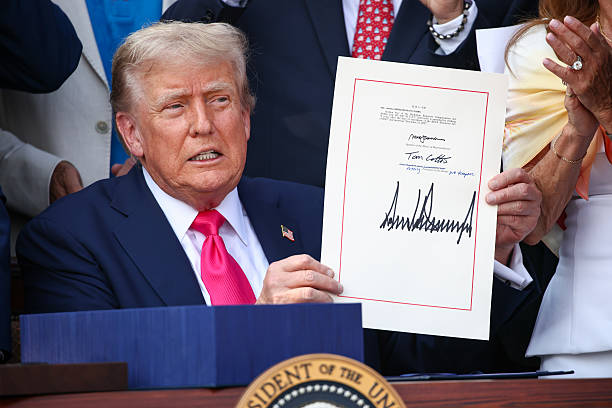Trump’s Big Beautiful Bill: Main Points of the New Legislation
Trump Signs “The One Big Beautiful Bill” Into Law | Photo by Samuel Corum for Getty Images
Story by Emerson Good || Listen on Soundcloud
Trump’s “Big Beautiful Bill” has officially passed both the United States Senate and House of Representatives and was signed into law by the President following a long and complex voting process. As it now begins to take effect, here’s a closer look at the major components of the legislation.
One of the bill’s most notable proposals was the elimination of taxes on social security benefits. While Trump initially sought to fully eliminate these taxes, Congress modified the plan to instead allow for partial deductions.
To offset revenue losses from tax cuts, the bill mandates significant reductions in Medicaid spending. This includes new regulations requiring recipients to re-enroll every six months instead of annually and work requirements for childless, able-bodied adults, mandating at least 80 hours of work per month to remain eligible. These changes are expected to create eligibility barriers that could cause many Americans to lose healthcare coverage.
Another provision in this bill is a temporary increase in the cap on state and local tax (SALT) deductions. Proponents argue this provides relief for high-income earners in expensive states, while critics warn it disproportionately benefits the wealthy and could deepen the federal deficit.
The Supplemental Nutrition Assistance Program (SNAP) is also affected. States will now be responsible for a larger share of funding, and able-bodied recipients without dependents will face stricter work requirements.
The bill also eliminates federal taxes on tips and overtime pay. However, the Senate added provisions to phase out this benefit gradually based on the recipient’s income level.
For American-made vehicles, the bill introduces a new tax deduction for loan interest payments, an effort aimed at boosting domestic auto sales.
On the child tax credit, the House and Senate reached a partial compromise. The House sought to raise the credit from $2,000 to $2,500 with eligibility tied to both parents having social security numbers. The Senate countered with a smaller, permanent increase to $2,200 and allowed eligibility if only one parent has a social security number. Final details are still being ironed out in committee.
The legislation also raises the debt ceiling, allowing the government to continue borrowing. The final bill settles between the House’s proposed $4 trillion increase and the Senate’s $5 trillion increase landing at $4.5 trillion.
Lastly, the bill includes controversial provisions around clean energy tax incentives. The House called for an immediate repeal of the Biden-era clean energy credits while the Senate advocated for a gradual phase out. The final version adopts a hybrid approach, with some credits ending immediately and others sun-setting over the next five years.
Despite the intense debates around the end, the Big Beautiful Bill is passed [by the House] on July 3rd, just one day before Independence Day, a date the President reportedly chose for symbolic impact. With implementation now underway, Americans are beginning to see the effects of one of the most sweeping pieces of legislation in recent years.

